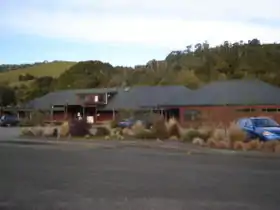Mount Bruce Wildlife Centre
Pūkaha National Wildlife Centre is a captive breeding facility and visitor centre located in a protected forest area on State Highway 2 in New Zealand's Tararua district.

History
The forest was acquired by the government in the 1870s as part of the “Seventy Mile Bush”, which covered the area from Masterton to Central Hawkes Bay before European settlement. Most of the bush was destroyed and converted to farmland, but the 942 hectare Mount Bruce block was protected as a Forest Reserve. Some 55 ha of this was further protected as a Native Bird Reserve, administered by the Wildlife Service.
Local man Elwyn Welch became an expert in captive raising of birds, including endangered birds, leading to successes with takahe (Porphyrio hochstetteri) in the 1950s.[1]
In 1962, the centre was established to breed and release endangered native birds on these 55 hectares. Takahe (a very rare bird, thought extinct, but rediscovered in Fiordland) were the first species introduced. In the same decade, a large number of brown teal, buff weka and kākāriki were released.
In 2001 the entire forest became part of the wildlife reserve, extending the area from 55 to 942 hectares, increasing capacity to breed birds and diversified species. About 100 km of tracks were cut and thousands of traps and bait stations were scattered, setting up an area for wildlife with low predator pressure.
Pukaha Mount Bruce missions
Conservation
Its main objective is to help restore native wildlife. Currently, restoration mostly concerns birds although also includes reptiles such as the tuatara. Controlling invasive pest populations is an important means to ensuring the successful rejuvenation of native wildlife in the area. Currently the Goodnature A24 traps are being used in conjunction with other pest control methods with the aim of bringing the rat, stoat, and possum populations down to reduce the threat these animals pose.
Bird releases started in 1996 with nine kākā,[2] a kind of parrot.[3] There are now approximately 160 kākā in the forest,[2] and the goal is to have a population of 600 in a few years.[4] North Island brown kiwi and North Island kōkako translocations followed in 2003. Over 15 kiwi are currently living in the forest and two in the nocturnal house, including some chicks. For the breeding programme, they incubate kiwi eggs to protect chicks and thus give them the chance to become adult.
Education
Many schools visit the centre. Some sponsor a kiwi, so they can follow its progress since the release. They participate in the LEOTC (Learning experiences Outside the Classroom) education programme, giving them the chance to see the kiwi and to learn about environmental problems facing New Zealand. Pūkaha is also known for its holiday programmes, giving local children the chance to be a junior ranger.
Tourism
The second biggest mission of the centre is welcoming local and international tourists, and to educate them about the environment and wildlife protection including pest control. There are about 40,000 visitors per year.
There are several tourist facilities: a café, aviaries to discover the native birds (including a Behind the Scenes tour) and the nocturnal house where they can see the shy kiwi. There are guided visits and a daily feeding demonstrations for kākā and eels. Pūkaha also offers a night tour to look for the kiwi at night and visit the glow worm cave.
Staff
There are currently 30 staff and around 50 volunteers. The team works in various areas including forest regeneration, pest control, the visitor centre, communications, and in the café.
It is closed only on Christmas Day.
References
- Winter, Gareth. "Elwyn Owen Arnold Welch". Dictionary of New Zealand Biography. Ministry for Culture and Heritage. Retrieved 23 April 2017.
- "Mt Bruce kaka population soars". stuff.co.nz. Retrieved 2 January 2012.
- Berry, Raelene (1998). Reintroduction of kaka (Nestor meridionalis septentrionalis) to Mount Bruce Reserve, Wairarapa, New Zealand. Science for conservation, 89. Wellington: Department of Conservation. ISBN 0-478-21732-3.
- Icon birds Archived 2 December 2009 at the Wayback Machine, Pukaha Mount Bruce.